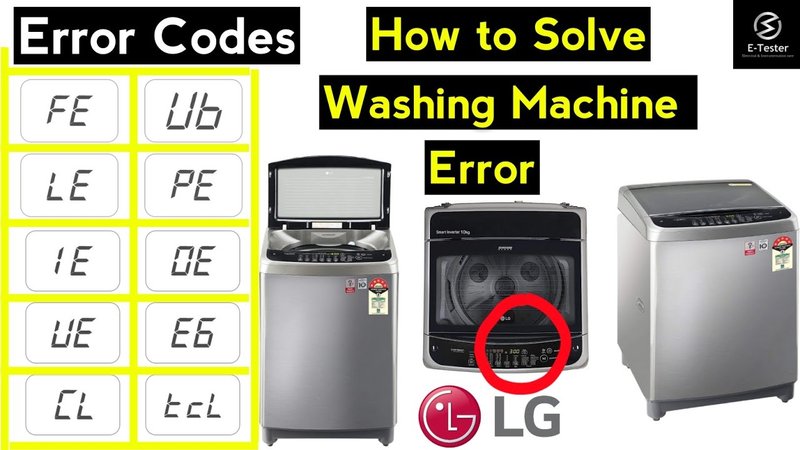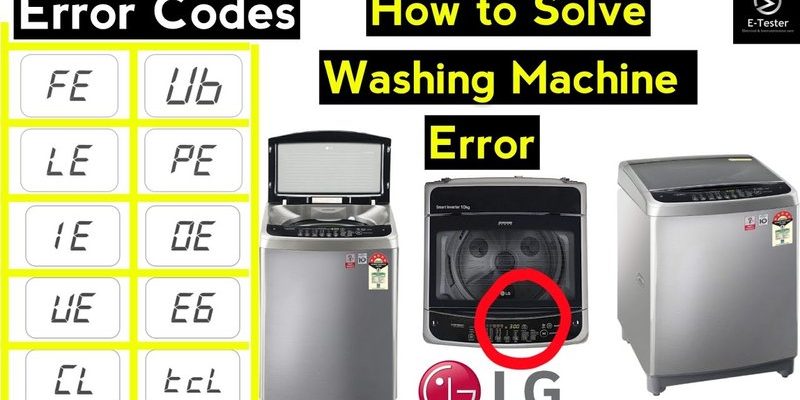
You might be tempted to ignore these error codes, thinking of them as minor hiccups. But here’s the deal: these codes are your machine’s way of telling you something’s not quite right. It’s like your washing machine’s version of the check engine light in your car. Ignoring it might lead to bigger problems down the line. So, should you ignore the E1 error code? Let’s dive deeper and see if it’s something you can safely overlook or if it needs immediate attention.
What Does the E1 Error Code Mean?
When your LG washing machine shows the E1 error code, it’s essentially letting you know there’s a water intake issue. Think of your washing machine as a big, mechanical sponge — it needs to soak up a certain amount of water to do its job properly. If there’s a problem getting enough water, the E1 code pops up to alert you.
The E1 error can often be linked to your machine’s water supply. Just like a clogged faucet might affect your water flow, a kinked or blocked hose leading into the machine can be the culprit here. The machine might not be receiving water because something is blocking its path, or the tap supplying the water isn’t turned on. Sometimes, it’s as simple as checking that the hoses are connected properly and the water supply is turned up.
Ignoring this code might lead to incomplete wash cycles or your clothes not getting clean. Imagine trying to take a shower with just a trickle of water — not very effective, right? That’s your washing machine’s dilemma when it struggles with an E1 error.
Why You Shouldn’t Ignore the E1 Error Code
Dismissing the E1 error code might seem like a harmless decision, but doing so can affect your washing machine’s performance in the long run. It’s a bit like ignoring that strange noise your car makes every time you drive — eventually, it could lead to a breakdown or a much costlier repair.
Addressing the issue promptly can prevent potential water damage. Say your washing machine keeps chugging along trying to pull in water that isn’t arriving; this persistent effort can wear down parts and, worst-case scenario, create leaks. Over time, this could cause water to pool around your machine, possibly damaging your flooring or surrounding areas.
Moreover, consistently washing clothes with insufficient water can lead to detergent residue, leaving your clothes not as fresh as you’d like. This can also lead to wear on your garments, much like over-washing or using harsh chemicals can ruin fabric over time.
Steps to Resolve the E1 Error Code
So what do you do when the E1 code appears? First, check the basics: ensure the water supply valves are fully open. It might sound too simple, but you’d be surprised how often they’re not. Next, inspect the hoses for any kinks or blockages. Think of it as checking for obstructions that could be stopping the water, much like checking a garden hose that’s not spraying properly.
If the hoses are fine, the issue might lie with the water inlet valve. This valve is like the gateway for water entering the machine. If it’s defective, it might not open properly to let the water in. Replacing a faulty valve might seem daunting, but think of it similar to replacing a part in a Lego set; it may require a bit of trial and error, but it’s doable with patience.
If you’re unsure or uncomfortable handling these parts, it’s best to consult a professional. Much like you’d call a mechanic when a car issue is beyond your DIY skills, a good repair technician can quickly diagnose and fix the problem, often preventing future headaches.
Preventive Tips for Avoiding the E1 Error
Prevention, as they say, is better than cure. Regular maintenance of your washing machine can go a long way in avoiding the E1 error and other common issues. It’s like keeping your car regularly serviced; a little effort now can save you big problems later.
Every couple of months, check your hoses for wear and tear. Just like a worn-out tire, old or damaged hoses aren’t effective and can lead to problems. Replacing them might be necessary if they show signs of aging or cracking.
Next, focus on your water quality. Hard water can lead to mineral build-up in hoses and valves, much like how lime scale builds up in kettles. Installing a water softener or regularly using a descaling solution can help in preventing this buildup. And remember, keeping your machine’s filter clean is crucial — it’s like making sure the filter in your vacuum cleaner isn’t clogged.
Finally, ensure you’re not overloading the machine. Like overpacking a suitcase can lead to a busted zipper, overloading your washing machine can strain its parts, leading to errors like E1. By following these preventive measures, you can keep your washing machine running smoothly for years to come.
In conclusion, while it might be tempting to ignore the E1 error code on your LG washing machine, addressing it promptly can save time, hassle, and potentially costly repairs. Keep your machine in top shape by understanding what it needs when these codes appear, and you’ll enjoy fresh, clean clothes without the drama of unexpected breakdowns.
